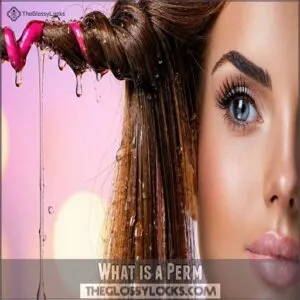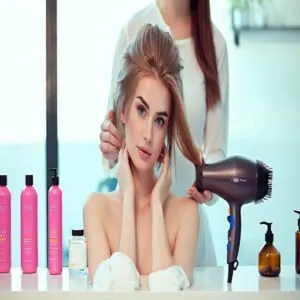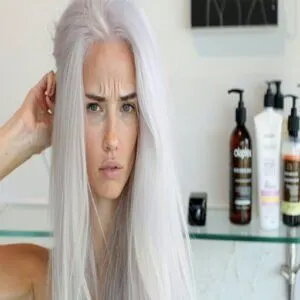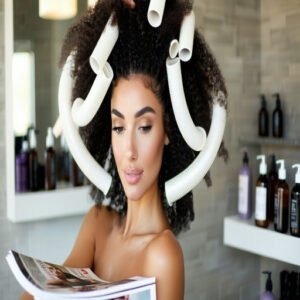This site is supported by our readers. We may earn a commission, at no cost to you, if you purchase through links.
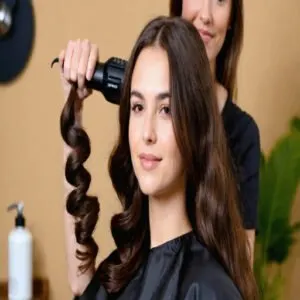 The best perm for fine hair boosts volume without weighing it down.
The best perm for fine hair boosts volume without weighing it down.
A body wave perm creates soft, natural waves that add fullness, while a root perm delivers subtle lift at the scalp for effortless volume.
For a casual, beachy vibe, go for a beach wave perm—loose, relaxed waves can bring life to thin strands.
Spiral perms are also great for defined, bouncy curls, but stick to larger rods to keep the look light.
Always consult a professional, especially for fine hair, and remember: moisture is your best friend post-perm!
Ready for a closer examination into styles and maintenance essentials?
Table Of Contents
- Key Takeaways
- What is a Perm?
- Types of Perms
- Considerations Before Getting a Perm
- Perms for Fine Hair
- Perming Bleached Hair
- Olaplex
- Goldwell Perms
- Frequently Asked Questions (FAQs)
- What style perm is best for fine hair?
- Should I get a perm if my hair is fine?
- What is the least damaging perm?
- What is the most natural looking perm?
- How can I protect my fine hair from damage during the perming process?
- How long does a fine hair perm take?
- Can perms for fine hair look natural?
- What are signs a perm is failing?
- Are there alternatives to perming fine hair?
- How do seasonal changes affect permed hair?
- Conclusion
Key Takeaways
- You’ll get the best results with a body wave perm or root perm, as they add natural-looking volume without overwhelming fine strands – body waves create soft waves for fullness, while root perms lift at the scalp.
- Before getting a perm, you’ll need to evaluate your hair’s health, porosity, and sensitivity to chemicals – damaged or overly porous hair won’t hold perms well and could suffer further damage.
- You should expect to invest $30-800 for the initial perm, plus ongoing costs for maintenance products and touch-ups – while DIY kits are cheaper, professional salon treatments are safer and more effective for fine hair.
- You’ll need to follow specific aftercare rules: wait 48 hours before washing, use sulfate-free products, avoid heat styling, and detangle with a wide-tooth comb instead of brushes to maintain your perm’s longevity.
What is a Perm?
Transforming your hair’s texture with a perm (short for permanent wave) involves a chemical treatment that adds stunning curls or waves.
The perm process reshapes your hair structure by applying a solution to break bonds, setting it on rods, and using a neutralizer to lock the new curl formation.
Perming fine hair requires careful hair perming techniques to avoid damage, but it’s perfect for adding volume and bounce, resulting in fine hair perm styles that can give you long-lasting texture and effortless movement.
Types of Perms
If you’re exploring the best perm for fine hair, knowing the options helps narrow down the perfect look.
Different styles cater to various vibes:
- Spiral Perms: Tight, uniform curls—great for turning thin hair into a voluminous masterpiece.
- Digital Waves: Softer curls or waves, giving you effortless texture and bounce.
- Root Lift: Adds subtle volume directly at the scalp, ideal for flat, fine hair.
- Beach Curls: Loose, relaxed waves for that breezy, just-walked-off-the-sand look.
Each method transforms fine hair into fine art! Understanding the various types of perm styles is essential for making an informed decision about the best perm for your fine hair.
Considerations Before Getting a Perm
Before getting a perm, it’s important to evaluate your hair type, lifestyle, and commitment to maintenance.
Taking these factors into account can help you achieve results that suit your needs without compromising your hair’s health.
Hair Type Compatibility
When choosing the best perm for fine hair, understanding your hair type can make or break the process.
Fine hair texture, scalp sensitivity, and hair porosity all play a role in how well your hair takes to the chemicals. Damaged hair or overly porous strands may struggle with long-lasting results.
To achieve the desired look, research hair perm types and their suitability for fine hair is vital for making an informed decision.
Here’s a breakdown to examine:
| Factor | Why it Matters | Best Approach |
|---|---|---|
| Fine Hair Texture | Prone to weaker structure | Opt for body or beach wave perms |
| Hair Porosity | Affects chemical absorption | Use milder perm solutions |
| Scalp Sensitivity | Reaction to perm chemicals | Consult a skilled professional |
For long-lasting volume without stress, talk to your stylist about safe options like bodywave perms for fine hair care.
Maintenance Requirements
Taking care of your curls is the key to making your perm last and keeping your hair healthy.
Proper hair upkeep guarantees those bouncy curls stick around. Start by skipping shampoo for 48 hours post-perm to let curls set.
Embrace gentler hair maintenance routines:
- Use moisturizing, sulfate-free products to prevent dryness.
- Detangle with a wide-tooth comb; brushes can ruin your curl pattern.
- Avoid heat styling tools; air drying is your best friend.
- Trim regularly to maintain curl preservation and prevent split ends.
For the best results, consider following a perm care guide to keep your hair looking its best.
Cost Considerations
Thinking about the best perm for fine hair? Let’s talk numbers.
Perm prices vary widely, with salon fees depending on location, stylist skill, and the type of perm. Here’s the gist:
- Initial Costs: A perm can cost $30 to over $800. Specialty treatments, like a volumizing perm for fine hair, often lean toward the higher end of treatment expenses.
- Maintenance Costs: Factor in ongoing expenses like touch-ups, trims, and curl-enhancing products. These add up fast in your hair budget!
- DIY vs. Salon: At-home kits seem cheap, but salon-performed perm solutions for fine hair offer better results and safety—worth the splurge.
Invest wisely in your hair’s transformation—it’s liberation in every curl!
Professional Vs. DIY
With salon services, skilled hair experts guarantee your fine hair perm is customized to your needs while minimizing perm risks.
For the best perm for fine hair, salons offer precision, though the best home permanents for hair can work with careful prep and research.
DIY tools promise affordability and flexibility but demand caution—chemical safety is no joke.
Perms for Fine Hair
If you’re looking for the best perm for fine hair, go for styles that add volume without overloading delicate strands.
Options like volumizing perms, body wave perms, root perms, and multi-textured perms work wonders for fine hair. These fine hair perm choices enhance hair curl patterns and create a natural, voluminous look.
To achieve the perfect style, consider incorporating easy hairstyles that complement your perm.
- Volumizing Perm: Loose curls give your hair fullness and bounce.
- Body Wave Perm: Soft waves offer a relaxed, natural texture.
- Root Perm: Lifts roots for effortless volume.
- Multi-Textured Perm: Creates varied, blended curls.
Perming Bleached Hair
Perming bleached hair isn’t for the faint of heart—it’s a balance between style and damage control.
Bleach weakens hair, and stacking a perm on top invites breakage without proper care. For safety, always strand test first.
Use perm solutions for fine hair designed for color-treated strands, like Goldwell’s gentle perms. Protect bonds with perming bleached hair with Olaplex, minimizing chemical risks.
Key tips:
- Avoid oversaturation.
- Stick to professional-grade solutions.
- Deep condition pre-perm.
- Choose bleach-friendly perm formulas.
- Be ready for frequent touch-ups.
- Minimize heat styling.
- Invest in routine hair repair treatments.
Olaplex
When you’re considering a perm for fine hair, maintaining healthy strands is a must.
That’s where Olaplex steps in as a game-changer. This hero treatment focuses on hair repair by rebuilding broken chemical bonds, which often get damaged during processes like perming.
For fine hair, it strengthens each strand, offering hair protection and making it resilient. Whether you’re using Olaplex at the salon or at home, it guarantees hair restoration, so you can embrace voluminous curls without compromising health.
Understanding the Olaplex perm process is vital for achieving the best results with your fine hair perm.
| Benefit | Result | Who It’s For | Why It Matters |
|---|---|---|---|
| Bond rebuilding | Stronger hair structure | Fine-haired individuals | Keeps delicate strands robust |
| Hair protection | Reduces chemical damage | Perm lovers | Safeguards hair during treatment |
| Hair restoration | Revives damaged strands | Permed, fragile hair | Enables healthier, lasting curls |
| Volume boost | Fuller, resilient locks | Fine, limp hair | Adds oomph and durability |
Goldwell Perms
Goldwell perms are a top-tier choice if you’re looking for the best perm for fine hair. They’re crafted with precision to protect delicate strands while enhancing hair texture and curl patterns.
- Gentle Solutions: With options like the Evolution Perm and Topform Biocurl Perm, Goldwell offers perm solutions customized to fine or even bleached hair, reducing hair damage while adding volume.
- Long-Lasting Results: Thanks to innovative pH-neutral formulas and a self-balancing system, your curls stay bouncy and natural-looking for months.
- Professional Application: Goldwell perms are expertly applied in salons using perm rods to achieve consistent curls or waves, ensuring minimal risk.
These treatments prioritize hair health while delivering stunning styles, making them one of the best perms for fine hair.
Frequently Asked Questions (FAQs)
What style perm is best for fine hair?
A body wave perm works wonders for fine hair, adding natural-looking volume and texture without overpowering your strands.
A body wave perm works specifically for fine hair types by adding the needed volume and texture, but there’s another option to consider.
Root perms are another great option, giving your hair a lift right where it counts—at the roots.
Should I get a perm if my hair is fine?
If your hair’s fine, a perm can add volume and texture, but it’s tricky.
Consult a pro to assess your hair’s health first, and opt for a gentle perm type to avoid damage.
What is the least damaging perm?
A digital perm is often the least damaging since it uses controlled heat to curl your hair, allowing for more precision and reduced chemical exposure.
Pair it with pre-conditioning treatments for healthier, long-lasting results.
What is the most natural looking perm?
Imagine effortlessly tousled waves that look like you just stepped off the beach.
For the most natural-looking perm, go for a body wave perm—it adds soft, loose waves, perfect for that carefree, lived-in look.
How can I protect my fine hair from damage during the perming process?
Start by deep conditioning your hair weekly for strength.
Choose a professional stylist who’ll use milder chemicals.
Avoid perming damaged hair, and ask for Olaplex during treatment to minimize breakage.
Gentle handling post-perm is essential.
How long does a fine hair perm take?
A perm for fine hair usually takes 2 to 3 hours, depending on the type of perm and your hair’s length.
The process includes prepping, applying chemicals, wrapping rods, and neutralizing to lock in curls.
Can perms for fine hair look natural?
With the right technique, perms can create soft, natural-looking curls or waves on fine hair.
Choosing loose waves or a body perm and working with a skilled stylist guarantees a realistic, effortless finish.
What are signs a perm is failing?
When your once-bouncy curls go flat,
it’s a clear sign your perm is falling apart.
Your hair may also experience other issues, such as frizz taking over like a bad hair day on repeat,
or your hair feels dry and brittle.
Are there alternatives to perming fine hair?
You’ve got options!
Try heatless curl methods like flexi rods, braiding damp hair, or using foam rollers.
Texturizing sprays or a volumizing haircut can also create the illusion of fuller, bouncy locks without chemicals.
How do seasonal changes affect permed hair?
Like a chameleon in changing weather, your permed locks react to seasonal shifts.
Humidity makes curls tighter and frizzier in summer, while winter’s dry air can loosen them.
Combat this with extra moisture and protection.
Conclusion
Like a caterpillar emerging as a butterfly, your fine hair can transform with the right perm.
Whether you choose a body wave, root lift, or beach wave perm, success lies in proper care and professional expertise.
Remember, the best perm for fine hair isn’t just about the style—it’s about maintaining your hair’s health throughout the process.
With these insights and your stylist’s guidance, you’re ready to embrace the volume and texture you’ve always wanted.
Take that first step toward your hair transformation today.

